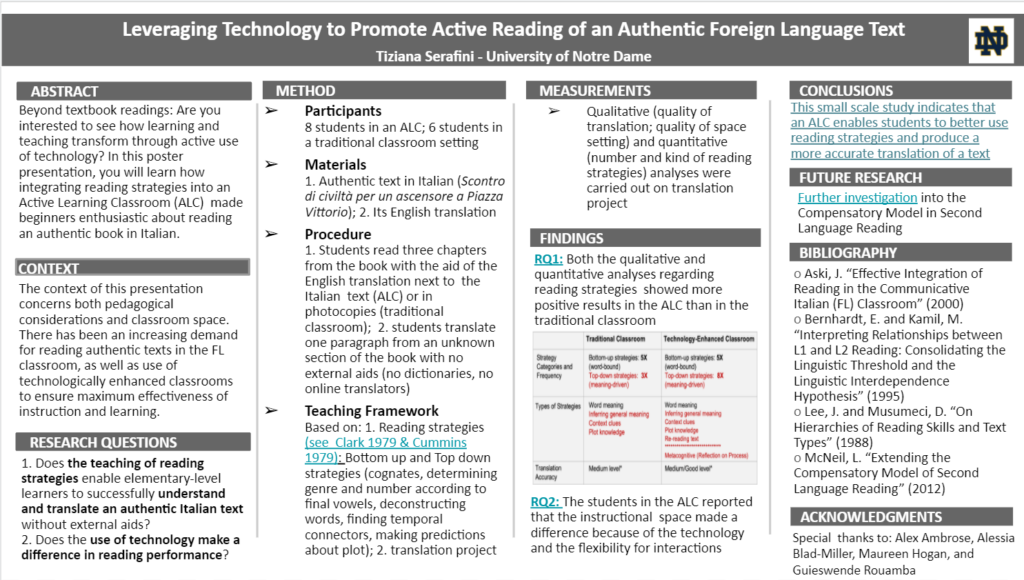
Click here to download or zoom in
Citation:
Serafini, Tiziana, , Rouamba, Guieswende, Ambroe, G. Alex (2021) “Translating Authentic Italian Text in a Technology-Enhanced Active Learning Classroom” Midwest Scholarship of Teaching & Learning (SoTL) Annual Conference. Virtual.
Abstract:
Beyond textbook readings: Are you interested to see how learning and teaching transform in a state-of-the-art active learning classroom? Through this poster presentation, you will be able to learn how integrating reading strategies into instruction in an active learning classroom made beginners enthusiastic about reading an authentic book in Italian.
Context:
In the summer of 2017, the University of Notre Dame was awarded a $65K furniture grant from Steelcase Educations’s Active Learning Center. Notre Dame’s Office of Facilities Design and Operations contributed $50k in classroom renovation funding and the Office of Information Technologies $25K in technology funding to renovate Debartolo Hall 232 into a state-of-the-art prototype flexible classroom to maximize interactive learning.
Research Goal:
Increase student confidence in reading authentic texts through instructional strategies in an online platform.
Research Questions:
• RQ1: Does the teaching of reading strategies enable elementary-level learners to successfully understand and translate an authentic Italian text without external aids?
• RQ2: How does technology support the development of reading skills in lower-level classes?
Lit Review:
Over the last few years, the shift toward a communicative classroom has resulted in reading being relegated to “the wayside” (Aski, 2000, p. 495). Despite being “one of the most obvious source of authentic FL language,” (idem) reading is often shunned by teachers and learners alike. Teachers may find it challenging to expose their students to unfamiliar vocabulary and grammatical structures, and students, in turn, may feel frustrated at syntactical and lexical complexity. How to come out of this gridlock? Some researchers chose to focus on text types and reading skills (Lee and Musumeci, 1988, p. 174). They asked whether establishing a hierarchy of text types and a corresponding hierarchy of reading skills constitutes an accurate tool to assess reading performance. Others turned their attention to the learners themselves, and analyzed the relationship between L1 (skill proficiency in ) and L2 (language knowledge) in successful readers (Bernhardt and Kamil, 1995).
Another line of inquiry centers upon cognitive psychology, and examines the ways in which learners and teachers can tackle authentic texts by learning and teaching reading strategies. Carrell and Eisterhold argue that at an elementary level “low-proficiency readers are more word-bound and [..] for them meaning tends to break down at the word level.” (1983). Schulz confirms that low-proficiency readers “engage in word-by-word decoding and translation,” (1983) and are often unable to gain a general understanding of a text. For this reason, Aski proposes teaching elementary-level students those strategies that focus on global meaning (top-down strategies). In contrast to bottom-up strategies, which concentrate on discrete, and oftentimes too challenging linguistic elements, top-down strategies allow readers the possibility to make logical inferences about general aspects of a text. Readers can then use that knowledge as a starting point against which they can test comprehension accuracy.
Is it, however, viable and constructive to also teach bottom-up strategies at a lower level? Is it possible for low-proficiency readers to apply both bottom-up and top-down strategies to an authentic text that is well above their reading level?
Methodology
A combination of quantitative and qualitative analysis.
Scholarly references
Aski, Janice. “Effective Integration of Reading in the Communicative Italian (FL) Classroom,” Italica, 77, No. 4, (Winter 2000): 495-508.
Bernhardt, Elizabeth, and Michael Kamil (1995). “Interpreting Relationships between L1 and L2 Reading:Consolidating the Linguistic Threshold and the Linguistic Interdependence Hypotheses.” Applied Linguistics 16 (1995): 15-34.
Carrell, Patricia, and Joan Eisterhold, “Schema Theory and ESL Reading Pedagogy.” TESOL Quarterly 17(1983): 553-573.
Lee, James and Diane Musumeci, “On Hierarchies of Reading Skills and Text Types.” The Modern Language Journal 72 (1988):173-87.